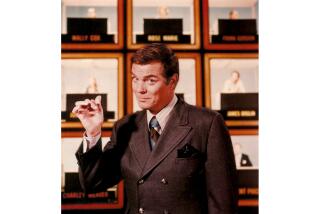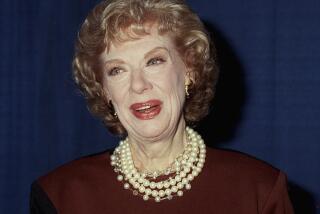‘Honeymooners’ night at UCLA’s Billy Wilder Theater
- Share via
It was Orson Welles who gave Jackie Gleason the moniker “The Great One” when the filmmaker and the comic genius were out on the town one night.
Gleason, who died in 1987 at age 71, was also known as “Mr. Saturday Night” because he dominated Saturday night programming on CBS from 1951 until 1970. Just as with Lucille Ball in “I Love Lucy,” the former nightclub performer became a superstar on TV in the medium’s earliest days, creating such beloved characters as the poignant Poor Soul, the exuberant Reggie Van Gleason III and the chatty Joe the Bartender.
But he’s best remembered for Ralph Kramden, the blustery Brooklyn bus driver who dreamed of a better life and never met a get-rich-quick scheme he didn’t like, on “The Honeymooners.”
Gleason introduced “The Honeymooners” on Oct. 5, 1951, when he was appearing on the small DuMont Network in the variety show “Cavalcade of Stars.” Pert Kelton played Kramden’s wife, Alice. Art Carney was his upstairs neighbor, sewer worker Ed Norton, and Elaine Stritch played Norton’s wife, Trixie. Stritch was replaced after that first episode by Joyce Randolph.
Less than a year later, Gleason had his own Saturday evening musical-variety series on CBS. “The Honeymooners” went with him, although with Audrey Meadows replacing Kelton. Those sketches continued until “The Honeymooners” became a stand-alone series on CBS in 1955-56 — those episodes are called the “classic 39” and are constantly seen in reruns — and continued when Gleason returned to the variety format the following season.
The UCLA Film and Television Archive has restored these early live “Honeymooners” sketches and is screening three of them Monday evening at the Billy Wilder Theater in L.A. Among those looking forward to the event is Gleason’s daughter, Geraldine Chutuk.
“I haven’t seen what the restoration is going to look like,” Chutuk says. “It’s been a long time coming. Other things I have seen restored makes you think you are looking at a live piece. One of the sketches they are going to be showing, ‘Jelly Beans,’ has never been seen before. It’s never been released, so this is going to be fun.”
Chutuk donated to the archive copies of the shows from the original kinescopes. “We have done digital restoration on them,” says Pauline Stakelon, digital initiatives specialist for the archive. “I think the image itself for a kinescope looks pretty great. They have good focus, and they have good contrast, so they are not really muddy like a lot of the kinescopes I have worked on. But in terms of dirt and scratches, there was a lot going on there.”
Chutuk says Ralph Kramden was based on people her father knew. “He used to say that Ralph and Alice lived above us in our apartment in Brooklyn,” she recalls. “In those days, you could hear everything in those railroad apartments. He knew a lot of people like that, and he took them from real life.”
Gleason’s characters also sprang from within, she noted: “You can pick a little part of each, and that was Dad at one time or another.”
According to Ron Simon, curator at the Paley Center for Media Study, all of Gleason’s’ characters “stretched back before World War II. Especially for urban audiences who first had TV sets, they indentified with his characters. It was really Ralph Kramden that sort of emerged as this one archetype that really represented a lot of the dreams and frustrations of many Americans. There was something topical about Kramden, but there was also something timeless about him.”
Simon believes there is a little Ralph Kramden in all of us. “I mean that is part of being an American — having this great dream. You have a scheme that somehow will make you rich and famous, but somehow it really always thwarts you. It’s become a tradition to show ‘The Honeymooners’ in New York on New Year’s Eve and Jan 1. I think it is sort of a dose of reality to all the great dreams of the new year.”
susan.king@latimes.com
More to Read
The biggest entertainment stories
Get our big stories about Hollywood, film, television, music, arts, culture and more right in your inbox as soon as they publish.
You may occasionally receive promotional content from the Los Angeles Times.











